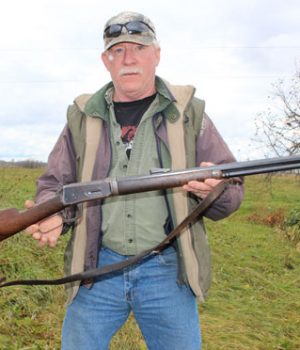by CONNIE TABBERT
Editor
BEACHBURG — Mick Kennedy enjoys his yearly trek up to the Beachburg area to hunt.
The 56-year-old hunter doesn’t believe he’s much different than other hunters, enjoying the camaraderie and tramping through the brush.
The also has his favourite guns to hunt with, both given to him by his father Bob, now deceased.
The first is a refurbished 303 British bolt action rifle that was manufactured in the early 1940s and purchased by his father following the second world war.
“It was standard issue in the Second World War,” he said. “I use it for hunting deer in the fields. It’s good for about 150 yards.”
Mr. Kennedy said his father purchased the gun for $14 and took it to Biedermann Sports, which used to be beside the Pembroke Memorial Centre, to have it changed. The wood that used to run along the barrel was removed and a site was taken off. The big brass butt on the back, that was there for endurance, was removed and a sponge mount was put on.
“It was a military rifle so it was heavy,” Mr. Kennedy said. “It would go through anything, you could fall in the dirt, bang it up against something, but it wouldn’t bend.”
The gun weighed in at about 11 to 12 pounds when it was military style. After it was refurbished, it weighed about seven pounds, he said.
“My dad had the wood taken off because it was too heavy,” he said. “It’s now almost half the weight of the original military issue.”
Mr. Kennedy’s other gun, a Winchester 32 Special lever action, was passed down through the family. His great Uncle Charlie Devlin first owned the gun. But, how he came into possession of it is not know, he said. Mr. Devlin was married to the sister of his grandmother Kennedy.
“My grandmother was May Brown and her sister Frances was married to Charlie Devlin,” he said. “He was not only a pharmacist, but owned the family foundry, Devlin Foundry, on Main Street in Pembroke.”
The foundry was known for its own brand of box stoves.
As a matter of fact, great Uncle Devlin built two cabins on his Mr. Kennedy’s grandfather’s property.
“He was a staunch outdoors man and spent time out there, time away from the wife, or whatever,” he added with a laugh.
An interesting fact about the cabins is the tin on the roofs are Pepsi signs. Explaining, Mr. Kennedy said back in the early 1940s, only pharmacists could sell Pepsi-Cola because it had codeine in it. Mr. Kennedy still has two of those Pepsi signs, One is a vertical sign with Pepsi 5 Cents written on it, while the other is a horizontal sign with a big chest of ice on it with the words Enjoy Pepsi Cola inscribed on it.
Going back to the gun, he said it’s 114 years old. It’s a tiger stripe maple that remains totally original, including the steel butt stock.
“It still works like a charm,” Mr. Kennedy said. “I use it to hunt deer,” which is what his Uncle Charlie and father used it for. “It’s good for anything within 100 yards.
“If we’re on a morning hunt on the oak ridges, I use this gun,” he said. “If we’re doing an evening hunt on a field edge, I use the other gun.”
He noted the bullets for the Winchester are much smaller than those for the 303.
Mr. Kennedy said the action on the 32 Special is as good as the day it was made 114 years ago.
“It’s absolutely fail safe,” he said. “I’ve heard so many over the years say, oh yea, I had an action lever and my gun jammed. The Winchester 32 Special does not jam. This just does not fail.”
The design of this gun was made in many calibres, including 30-30s, 40-44s and 25-20, he said.
“It’s design was so good, it was reproduced in multiples,” he said.
However, he does not know how many of the Winchesters are around that are as old as his gun, which was made seven years after the original, which was patented in 1894.
“This is a rare model because it comes apart,” he said.
This also has an octagon barrel, which is more expensive, than the round barrel, he said. The deer guns have a carbine model, which is a 20 inch barrel, which is six inches shorter than the original model.
“You lose accuracy and range, but it’s lighter and better to carry,” Mr. Kennedy said.
He likes this gun, not only because it’s a family heirloom, but because of its age, the patina that still shines through, the natural wear, and seeing where it’s been worn off here and there.
“It’s also just a real nice piece of engineering,” Mr. Kennedy said.
He can load nine shells in the barrel and another in the chamber and each time the lever is pulled, the shell comes out and flies to the right and the lever picks up the next shell and puts it into the chamber.
“You can do shots in less than a second,” Mr. Kennedy said.
He compared that to a semi-automatic, which can shoot in quarters of a second.
“You can always the tell who are using semi automatics, because it’s not just one or two shots going off, it’s bangbangbangbangbang,” he said.
“This is a more controlled shot, remember, it’s 1894 technology.”
Tossing in some trivia, Mr. Kennedy said, the guy who designed the Winchester was not named Winchester.
“His name was John Browning and he was a firearms designer,” he said.
“He had no money for manufacturing the rifle, so he sold the design to Winchester and this is probably the most common, most produced gun, the 1894 Winchester model in North America,” he said, adding, “It’s made in every calibre, all kinds of models, short barrel, long barrel, you name it.”
To cut production costs, Winchester switched to a different manufacturing process sometime in the early 1960s, he said. A Winchester made after the new manufacturing process is worth about $300 to $400.
However, he has had his appraised, and it’s worth up to $4,000, he said.
He noted the 32 Special still has the original buckhorn site, “which is awesome compared to the scope.” When using a scope, it’s difficult to pick up the target first and all a hunter sees is a patch of trees. However, with the buckhorn site, a hunter can zero in very fast because he is aligning up the target between the posts.
Growing up, Mr. Kennedy said this rife used to “hang on the back stair case, half the time it was loaded. For whatever reasons, it was just loaded and hanging there.”







![Kenopic/Smith Auction [Paid Ad]](https://whitewaternews.ca/wp-content/uploads/2018/10/advertising-100x75.jpeg)

